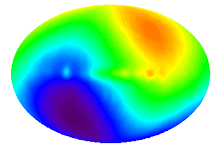ER stress-induced inflammation: does it aid
or impede disease progression
Schematic representation of IRE1a -mediated,
ATF6-mediated, and PERK-mediated inflammatory transcriptional program.
Following ER stress, PERK activates NF-kB via translational attenuation.
The activated PERK-eIF2a arm causes
translational arrest, which leads to decreased levels of IkB protein and a consequent increase in the ratio of NF-kB to IkB. This change in the ratio
causes the release of NF-kB protein, which then carries
out its proinflammatory transcriptional role in the nucleus. Similarly, the
PERK-eIF2a arm also carries
out immunomodulation via CHOP, which activates transcription of the gene for
IL-23, a proinflammatory cytokine. PERK-eIF2a causes CHOP
production via ATF4, whose mRNA is transcribed only under conditions of
translational attenuation. Interestingly, it was recently observed that ER
stress-induced CHOP activation can also negatively regulate the inflammatory
responses by modulating NF-kB as well as JNK (leading to modulation
of downstream AP-1 activity). By contrast, ER stress can also cause the
activation of IRE1a ,
which can then bind the tumor-necrosis factor (TNF)-a-receptor-associated factor 2 (TRAF2). Importantly, this IRE1a –TRAF2
complex can activate IkB kinase (IKK). Activated IKK
then causes IkB degradation, thereby freeing
NF-kB to transcribe the
proinflammatory gene program. Similarly, the IRE1a –TRAF2
complex has also been shown to activate the JNK protein, which consequently
phosphorylates and activates AP-1 (which in turn transcribes its own
inflammatory gene program) [99]. Finally, under conditions of ER stress, ATF6
can leave the ER and reach the Golgi complex, where it can undergo ‘regulated
intramembrane proteolysis’ (RIP). During RIP, ATF6 is cleaved by local site 1
and site 2 proteases (S1P and S2P) [6,100]. The activated ATF6 fragments form
homodimers and transcribe acute-phase response (APR)-associated genes, such as
those encoding acute-phase proteins (APPs) [6,101].
ER stress-induced inflammation in health
and disease. Crosstalk between inflammation and ER stress can either aid or
impede the pathogenesis and/or progression of certain diseases. For instance,
ER stress-induced inflammation and even ER stress on its own, can affect
pancreatic b cells as well as adipocytes and
macrophages, thereby aiding the progression of type 2 diabetes and obesity,
respectively. Obesity-associated inflammation can further aid type 2 diabetes
progression by suppressing insulin receptor signaling. Similarly, ER stress-induced
inflammation can affect intestinal epithelial cells, Paneth cells, and goblet
cells, possibly aiding the progression of inflammatory bowel diseases (IBDs)
such as Crohn’s disease and ulcerative colitis. Furthermore, ER stress-induced
inflammation has been implicated in aiding the progression of cystic fibrosis
and cigarette smoke-induced chronic obstructive pulmonary disease, both of
which are chronic inflammatory airway diseases. However, the link between ER
stress-induced inflammation and cancer is not as simple, although ER
stress-induced inflammation has been shown to aid tumorigenesis, it has also
been shown to impede tumorigenesis by inducing immunogenic cell death-based
antitumor immunity.

沒有留言:
張貼留言